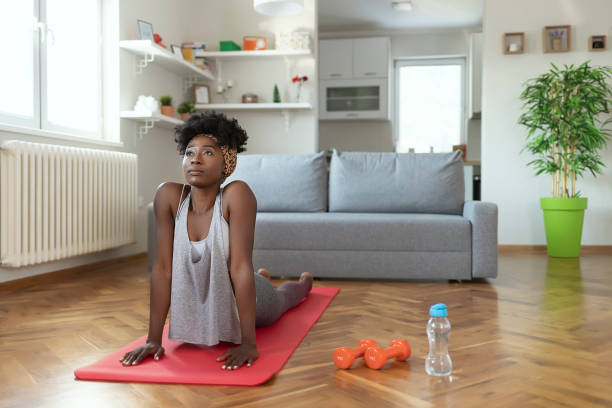
Anyone who gets frequent migraine symptoms knows the experience: the throbbing, the pain, the visual disturbances. Black patients are more likely to have more frequent headaches that may be undertreated or underdiagnosed, according to the National Center for Biotechnology Information.
Exercise has long been a potential way to reduce migraine triggers, but a new study suggests it could be especially effective with triggers such as stress, depression and trouble sleeping.
"It's a complex relationship, but we know that exercise, generally speaking, helps increase levels of good neurotransmitters, like dopamine, norepinephrine, serotonin, which contribute to not only fewer headaches, but also better mood and overall well-being," study author Dr. Mason Dyess, a senior fellow at the University of Washington School of Medicine says.
Exercise also improves heart health and that helps with weight management, which is also associated with better migraine control, Dyess adds.
The study included more than 4,600 people diagnosed with migraines. About 75 percent had 15 or more migraines a month. The other 25 percent had 14 or fewer.
Study participants completed a questionnaire about their migraine characteristics, sleep, depression, stress and anxiety. They also answered questions about how much moderate to vigorous exercise they got each week -- jogging, very brisk walking, playing a sport, heavy cleaning and bicycling, for example.
Researchers divided participants into five groups by frequency of exercise ranging from none to more than 150 minutes per week, the minimum recommended by the World Health Organization (WHO). About 27 percent got the recommended amount or more.
Participants who got less exercise than recommended had increased rates of
depression, anxiety and sleep problems, the study found.
Researchers found that 47 percent of the people who did not exercise had depression; 39 percent had anxiety, and 77 percent had sleep problems.
By comparison, about 25 percent of the most active group had depression; 28 percent had anxiety, and 61 percent had sleep problems.
The study also found a link between exercise and headache frequency. In the no-exercise group, five percent had zero to four headache days a month, while many more -- 48 percent -- had 25 or more headache days per month.
In the high exercise group, 10 percent had low headache frequency and 28 percent had high headache frequency.
Dr. Mark Green, a member of the National Headache Foundation's Health Care Leadership Council and a professor of neurology at the Icahn School of Medicine at Mount Sinai in New York City, urges migraine sufferers to be cautious about their exercise routines.
Consistency is key, whether it comes to exercise or other activities that can be beneficial, such as controlling caffeine, wake and sleep hours, eating and hydration, Green says.
He suggests his patients begin a routine of walking on a treadmill for 3 1/2 miles at an incline of 4 degrees every day. He recommends increasing the angle, not the speed, if someone wants more of a workout.
"I don't want it to be jogging. I want it to be walking fast. Three and a half doesn't sound like anything, but it's actually faster than you think at 10 degrees," Green shares. "That tends to work out well."
Migraines are complex and people who experience them do so for a variety of reasons. Yet there are some vital common denominators, Green notes.
"In general, it's influenced by genes. To give you an example, if you have migraines, your children have a 50 percent risk of developing migraines. If both parents have migraines, the risk is about 80 percent of developing migraines," Green adds.
In addition to low-impact exercise, Green advises his patients to eat multiple small meals a day, get consistent hydration and maintain consistent sleep schedules. He tells patients they need not limit caffeine intake but they also should
not vary their caffeine routine.
"I tell people with migraines you have a brain that doesn't like change -- it likes constancy," Green says.
Researchers note that the study only shows a link between exercise and migraine triggers and doesn't prove cause and effect.
Dyess suggests migraine sufferers work more activity into their daily life. He recommends starting with gentle yoga, then building up to a brisker routine. That could include jogging, depending on the patient, he adds.
"Exercise is such a cheap and accessible treatment option for people that's just widely underutilized," Dyess says. "I think awareness is powerful in this situation. It really can change lives anywhere and everywhere if utilized by patients."
Exercise Tips
As mentioned before, if you are suffering from migraines consider trying the following for relief:
- Yoga: Yoga can help with tightness in your muscles, poor posture and stress (common symptoms that make your headaches worse). Restorative yoga has proven to be successful for those suffering from headaches. This method involves deep breathing with poses that are fully supported by props (blankets, mats, blocks, etc.). If you are new to yoga, you may want to start out light with yoga that frequently changes poses instead of ones that hold them for long periods of time.
- Stretching: Try stretching your arms, legs and neck for 10 minutes a day. This will provide greater mind and body awareness and help with breathing and tension control.
- Deep Breathing: When we are stressed, our muscles need oxygen the most. Try putting one hand on your abdomen and the other hand on your upper chest. The hand that is placed on your abdomen should move when you're inhaling if you are taking proper deep breathes from your diaphragm. When you exhale, the hand that is placed on your chest should remain still. Once you get the hang of this breathing exercise, you should commit to doing this for several minutes a day.
- Progressive muscle relaxation: Learning to relax your muscles may reduce the emotional and/or physical stress that can lead to headaches. Try sitting or lying in a comfortable position with your eyes closed. Tense the muscles in your legs for 10 seconds and then release the tension for 20 seconds. This technique works really well with the muscles in the abdomen, chest, arms and face. This technique is more efficient when you are consistent, so dedicate 10 minutes a day to this.
- Cardiovascular Exercise: Cardiovascular or aerobic exercise not only works out the heart and lungs, but also reduces stress, anxiety, depression and anger (common headache triggers).
The American Headache Society recommends 150 minutes of moderately intense activity per week. If you notice that exercising is triggering your headaches, contact your doctor.
You may also try:
- Staying hydrated before, during and after exercise
- Eating 90 minutes before exercise
- Warming up





